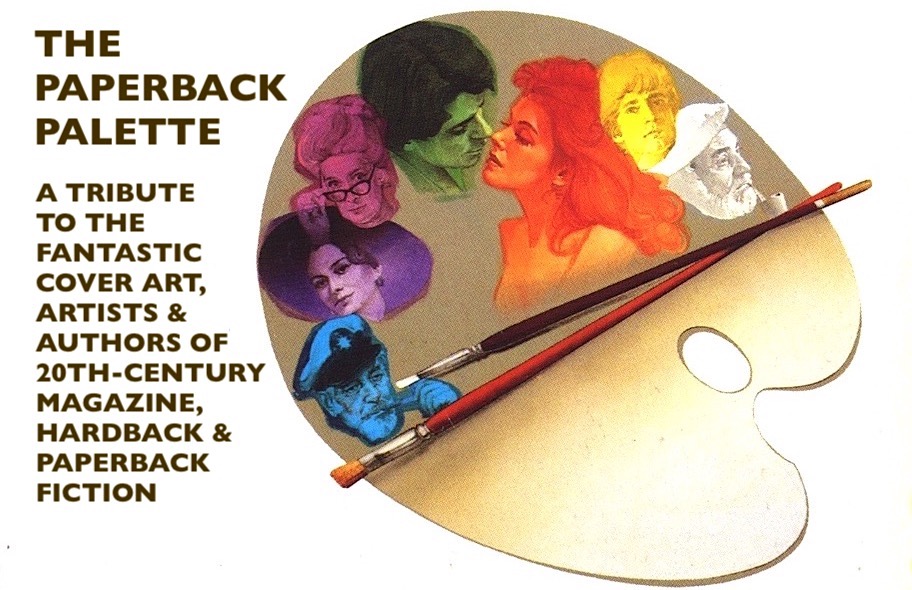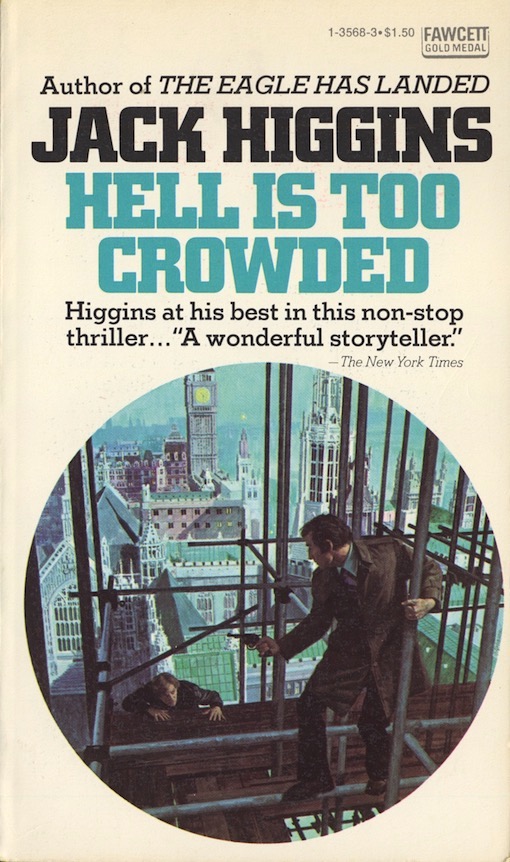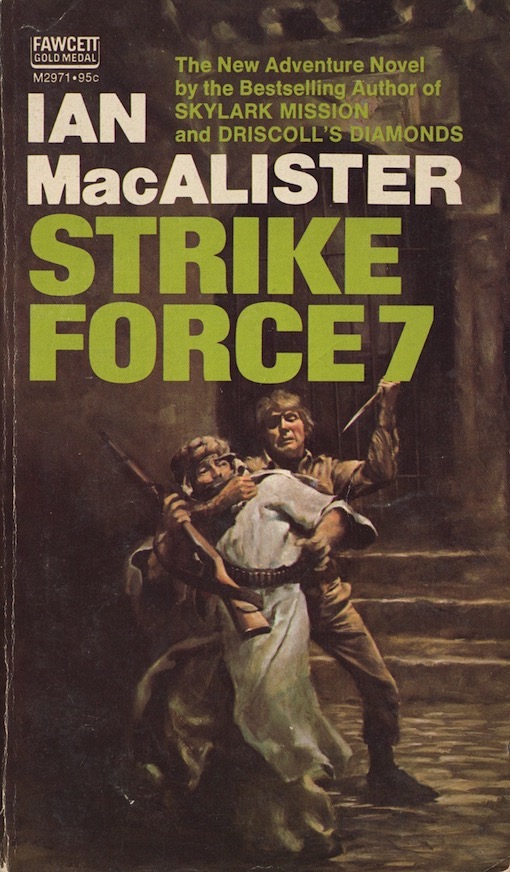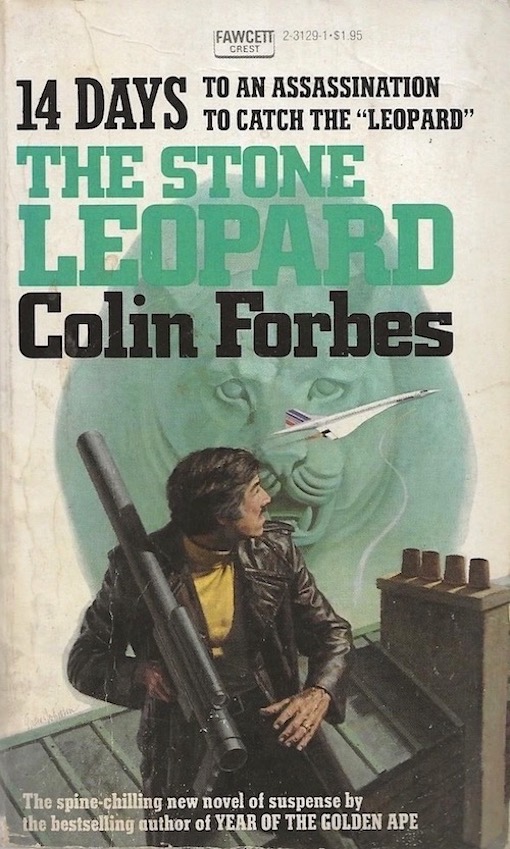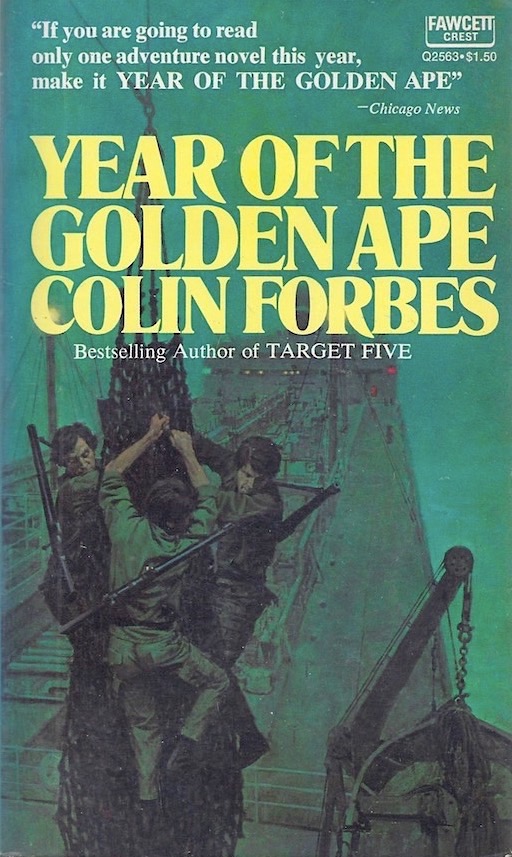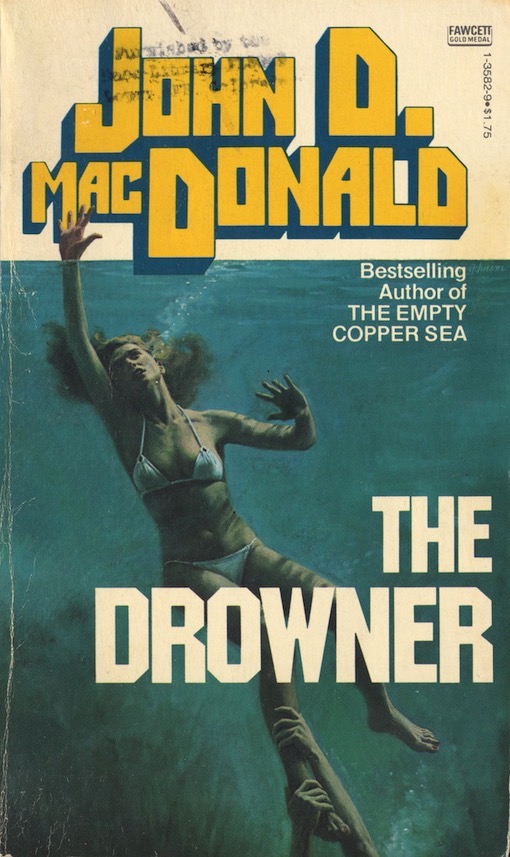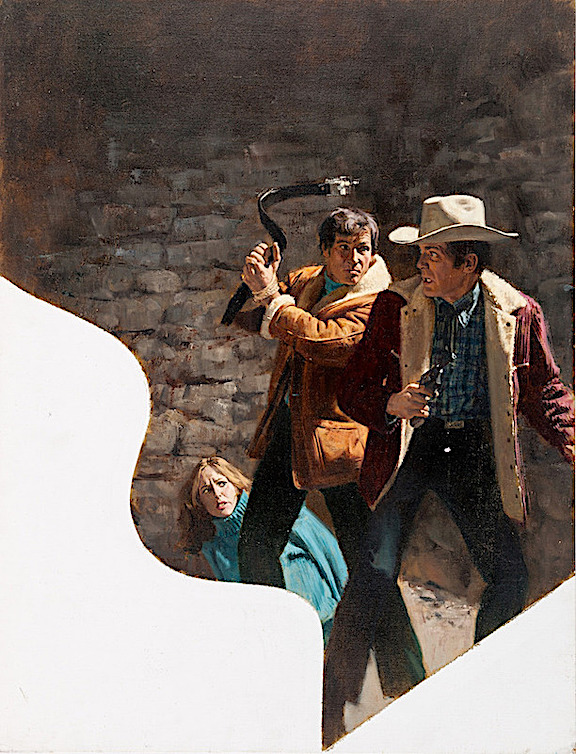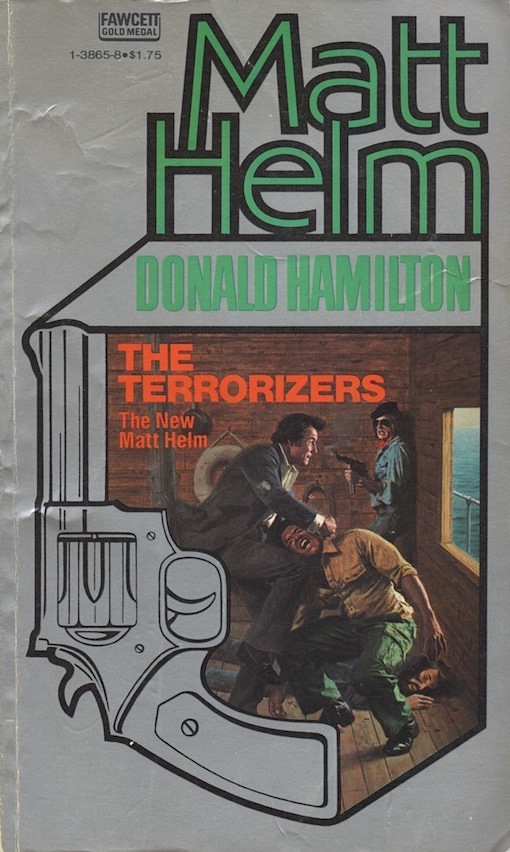After five years of doing articles I'm starting to run out of adjectives to use when describing my favorite book cover artists--fantastic, incredible, quintessential, iconic, visionary, star-spangled, major, master--what's left to use now? Well, how about "consummate." It's as good an adjective as there is and it seems to fit Gordon Johnson like paint on canvas.
Johnson, apparently, was born in 1924. His artistic forte was realism, starting with the illustrations he produced for various magazines in the mid 1950's, such as The American Magazine, American Weekly, Outdoor Life and Boys' Life. It would seem that Johnson's first book commissions, or those that I've been able to discover, adhere from about the mid-1960's and constitute mostly teen titles from publishers like Grosset & Dunlap and Whitman. Though from that point on Johnson did what all "consummate" illustrators did when the great Silver Age of Mass-Market Paperbacks got heralded in, he began producing cover art for nearly every major paperback house in New York City. Along the way he mastered each and every genre that stood before him, the "fantastics" being perhaps his only overlook. He tirelessly kept at it too until 1989, when death came suddenly knocking at his door at the age of 65.
For this article, I am going to feature Johnson's more modern, contemporary covers, representing action, adventure, drama, and romance. I will save his many marvelous historicals for a follow-up post.
'Christina had been warned against going to Skye Manor, against the ominous old house with its locked doors, buried secrets and blood-chilling cries in the night. But Howard was there and she was determined to be with the man she intended to marry, no matter how frightening the rumors. Yet when the rumors suddenly flared into nightmarish reality with one horrible act of violence after another, Christina knew that something inhuman was on the loose-- and that she was trapped by her love in an icy drama of unspeakable terror.'
'The terror begins without warning. The cat suddenly dies of poison. At that moment Rueben Bourne has no inkling of its significance. The bit by bit the full horror of it is unleashed upon him. He knows now that he and his family have become the target of a powerful and paranoid right-wing fanatic---a man who will not rest until Bourne, his wife and children are exterminated! Where can they run? What can they do? How can they save themselves from this madman's obsessive hate?'
'Sixteen year old Meg Grant loves her mother and the Bohemian life they have as European tour guides. Everything is fine until Meg's mother is diagnosed with cancer. Now Meg must meet the father she has never seen and live a life she has never had.'
'American diplomat Payton Pleydell and his wife Sylvia are the most respected, brilliant couple in Washington. Theirs seems a perfect marriage but Kate Jerold begins to suspect that her cousin's husband is not as devoted as he seems. Then the unexpected arrival of a Czech official threatens to bring the facade crashing down. Even after six years apart, Sylvia has not forgotten Jan Brovic; during the war they had been deeply, secretly in love. But now there is a new war, and former allies have become bitter enemies. Jan is on the other side and his motives may not be pure. Separated by the enmity of nations, Sylvia must decide whether to risk everything to be with the man she loves.'
'Paul Chavasse had everything a good agent needed. Flair, ingenuity, a superb intelligence, common sense--plus a willingness to kill. Now he was part of the walking wounded. So badly hurt on his last mission they figured he was through. But Chavasse was far from through. A few months of special training and he was ready to take on one of the most dangerous men in the world. Max Donner. A millionaire with his own private army and a plan for stealing Britain's newest secret missile. Paul was ready for Max Donner. But he was not ready for Donner's beautiful young stepdaughter, Asta.'
'Martin Fallon was a professional rebel. On the run. Just about everyone wanted him---the Special Branch, Military Intelligence, the I.R.A. Fallon was not a murderer. But now murder was part of his deal with Dandy Jack Meehan to get a passport and enough money to get out of England. The job was a simple one for a sharp-shooter like Fallon. But there were unexpected complications. Two witnesses. A priest. And a beautiful young woman. Would Fallon have to kill them, too?'
Higgins' Toll for the Brave was originally published in the United Kingdom in 1971. Fawcett Gold Medal issued this American paperback edition in 1976. Johnson's cover art gives us a glimpse of Britain's Stonehenge, always an excellent selling point for any story.
'Ellis Jackson. A war veteran whose war was now with himself. Accused of murdering his mistress and his best friend, he was driven to the edge of sanity. Somewhere deep inside him he knew he had not done this terrible thing. He had been set up. Framed. He also knew nobody would believe him. Not unless he could prove his innocence. But first he had to escape...'
'The face swimming at him out of the fog. The strange young woman appearing suddenly. The invitation to her flat. The offer of a drink. The drink was the last thing Matt Brady remembered. When he woke, the police were swarming about---and the body of the girl was lying near him on the floor. Of course, the did not believe his story. He was charged with murder and sent to prison for life. There were few prisons strong enough to hold Matt Brady. And Matt knew he had to break out of this one fast. He had to find out the truth behind this bizarre nightmare. Who wanted to frame him? Who wanted him out of the way? All he remembered was a face in the fog, a half-remembered face that was his only link with sanity...'
The Keys of Hell was originally published in the UK in 1965 under Higgins' pseudonym Martin Fallon. Fawcett Gold Medal published this first American paperback edition in 1976. This is perhaps my favorite action illustration out of all the ones I've seen from Johnson (more to follow below). I love the poses and expressions.
'Paul Chavasse was looking forward to his holiday when the Chief said, "There's a simple little job I want you to do first." Of course nothing the Chief wanted was either simple of little. It was usually large and lethal. This time Paul's assignment was to get into Albania and put a dangerous double agent out of commission---permanently. What he did not know was that someone had set a trap. For him. Someone who had waited a long time for revenge. Now the indestructible Chavasse, whom no one could out-thing or out-fight, was headed straight for destruction---and Hell...'
Higgins' Wrath of the Lion was originally published in the UK in 1964. This Fawcett Gold Medal reprint with cover art by Johnson was issued in late 1976 or early 1977.
'Neil Mallory---tough, experienced veteran of more wars than he cared to remember---was in a new business now. Which is why he watched so carefully when Anne Grant left the bar followed by two strangers. When he heard her cry out a few minutes later, Mallory knew it was time to rescue her. She was very grateful, in fact, she offered him a job. She did not know then that it was exactly what he was waiting for, that the attack on her was all part of a very dangerous game of intrigue and violence. Nor did she know she was the key to it all...'
'The Russians trained him and planted him deep in the hottest spot in the free world-- Northern Ireland. He had the perfect cover and the perfect plan-- to kill the most beloved man on earth. Too late the Russians changed their minds. He was out of their control. Desperately the IRA tried to head him off. But he was even better than they at the undercover game. So Tony Villiers of British Intelligence had to do what he most hated. He had to have his Agency beg the help of Liam Devlin, former deadly foe and Irish terrorist, and the only one who could stop the ideal assassin before his victim unknowingly welcomed death with open arms...'
'His name was Sam Watchman... He was a full-blooded Navajo Indian. He was also a cop. And he had an assignment. A rough one. He had to find and capture an ex-Green Beret officer. A desperate and dangerous man hiding in the blizzard-racked mountains of the great Southwest.'
'It's this simple," Royan told Driscoll. "Either you come out of the water with those diamonds, or Shana dies. Right here. Today." It was not the kind of ultimatum Driscoll cared for. They were, after all, his diamonds. And Shana was his girl. But Driscoll had no choice. He was unarmed and pitted against the one man in the world who was smarter than he was---Royan had taught him everything he knew. Driscoll headed for the water, for the wreck caught somewhere in the reefs under the sea off the African shore---the drowned plane hiding its treasure of stolen diamonds. But something had triggered itself in Driscoll's mind. There might just be a way out of all this---if Royan was the kind of man he was supposed to be---and Shana was still his girl....'
'An assassination attempt on the French President, Guy Florian triggers off a savage manhunt for the notorious resistance leader known as the "Leopard." Although the records show the Leopard has been dead for years, Police Prefect Grelle is not convinced. He is very impressed by the strange story of an ex-convict who tells him he has seen the Leopard and that he is someone very high in the government. Before he can say more he is murdered. The team of Soviet killers sent into France to eliminate witnesses to the Leopard's real identity is already at work. Swiftly Grelle begins to close in on them. But each time they elude him. Now he knows something very big and very deadly is about to unfold. Grelle knows, too, he must unmask the Leopard before he destroys France itself...'
'A homemade Atom bomb... A fanatic Arab Sheik straight out of the dark ages... A violent paid killer who enjoys his work... A brilliant English adventurer always on the wrong side of the law and the right side of the money... Arab and European terrorists straight out of tomorrow's headlines, blackmailing the world with a bomb capable of destroying a city---a city like San Francisco...'
My goal is to read all of Alistair MacLean's best adventure novels. I'm at seven so far, with thirteen more to go. That's right, only twenty of his thirty-one novels are considered to be good, or great, the ones written after Breakheart Pass are all mostly crap, or so says almost everyone who's read them. The Golden Rendezvous is one MacLean's early novels and thus among his very best. It was initially published in the UK in 1962, and then republished again and again in paperback on both sides of the Atlantic. This edition, published by Fawcett Gold Medal with Johnson's cover art, is circa 1977.
'A luxury cruise... A missing atomic scientist... A hidden nuclear device... A very rich and beautiful woman... A band of desperate hijackers... A ship of gold. Put them all together with First Officer John Carter, tough, shrewd, resourceful, and you have a fantastic blend of suspense---adventure and international intrigue.'
'October is no time to be aboard ship in the Barents Sea, three hundred miles north of the Arctic Circle. But that's where the cast and crew of Olympus Productions find themselves. And even before they reach their destination, the ship's doctor has his hands full. Three men are violently murdered, and the company's unspoken fears are confirmed: a pathological killer awaits them on the loneliest, most desolate island in the world. Does Bear Island guard a secret more valuable than five lives? Why is there no shooting script for the movie--and why has no one except the director been allowed to see the screenplay? Is the entire company marked for death? Does a mass murderer lurk in its midst, a pathological killer?'
'Winters are silent in Budapest, silent and dark, and behind some door in some ancient street Harold Jennings, the brilliant British scientist, sat rehearsing a speech denouncing his own country. The Communists intended to use Jennings' speech as the propaganda coup of the decade. The British were equally determined that it should never be delivered. Michael Reynolds, Britain's top agent, was given the impossible assignment---enter Hungary, kidnap Dr. Jennings and return him to the free world; and this, Reynolds decided, was roughly like trying to find an invisible needle in a burning haystack.'
'Lucille Hanson had rid herself of the wrong man---her rich husband who lived casually and loved carelessly. Then she found another man she hoped would be right. She was putting together the pieces of her life---until all of her hopes came to rest at the bottom of a lake where her body was found. It must have been an accident, was what most people said. It might have been suicide, was what others wanted to think. But among her mourners just one person refused to believe it was anything but murder...'
This very first paperback edition of The Retaliators was published by Fawcett Gold Medal in 1976.
'Matt Helm was unexpectedly rich and he didn't like it. The $20,000 that had been deposited in his account was a complete surprise. Very nice. Except Matt knew that someone was setting him up, making it look as though he was a traitor and getting a payoff. Someone who wanted Matt out of business. Suddenly, another secret agent with an unexplained surplus in his bank account was murdered. Matt figured he'd better track down his "benefactors" before they retired him for good.'
'This one was murder from the start. A lovely red-haired lass whose amateur standing as a secret agent had been cut short by some very professional killers. The strange part of it was that she wasn't even on assignment. Nobody had a clue as to what she'd found. But obviously she'd found something... something very big and very bad. Too much for her, but just the right size for Matt Helm.'
'In a little town on the Mexican coast a young American woman is under heavy guard by US agents--and under heavy surveillance by Soviet operatives, including Matt Helm's old mistress Vadya. The captive woman claims not only to have witnessed a flying saucer, but to be the only survivor of its attack on her boat. Helm is to accompany her back to the States--or to kill her instantly if it looks like the Russians are eve getting close to a snatch.'
Ah-ha! Now we see how Johnson adjusted. This revolver edition of The Silencers was published by Fawcett Gold Medal circa 1977.
'Matt Helm, the undercover agent with a killer instinct and a weakness for the wrong woman takes a long day's journey into the New Mexico mountains and finds--God help us all--a crumbling, ghost-town church which conceals one of the most ungodly devices ever conceived for man's destruction.'
"When they fished him out of the bay and he woke up in a Canadian hospital, he had no idea who he was. The plane crash had wiped his mind clean of the past. Then this gorgeous chick waltzed into his room and told him he was Paul Madden, a photographer, her fiance, which seemed like a pretty good deal. Except when some joker called on the phone and told him he was Matt Helm. Somehow he knew this meant trouble. Bad trouble."
'Matt Helm finds out just how fatal blond hair can be when he takes over another man's identity, fiancee, and fate. In this mixed-doubles counter-espionage mission, Helm plays decoy for an assassin's dream... to kill the next President of the United States.'
'A brutal journey into the bitter, silent world of a government assassin, where calculated killing occurs in subtle ways and strange places--and where wracking torture is a predictable rule of the game. Matt Helm finds himself torn between the neurotic urges of a gangster's headstrong daughter and a threat to the life of the woman to whom he himself had once been married.'
'An agent like Matt Helm might be a nice man to live with for a while---but he's not the kind a woman would want to marry. Unless, perhaps, she had to---unless, perhaps, the marriage was part of an ingenious cover. Here the man whose daily bread is violence takes himself the most unlikely bride in the world---just to make sure that death doesn't part them...'
'The department is gravely concerned about Helm. He is on a brutal mission, it is true---but his own callousness seems to have reached a point of absolute savagery. He has apparently murdered on of our own agents. Helm is on or near Chesapeake Bay. He is armed and dangerous, and must be located, kept under surveillance, and possibly removed from active service.'
'Far out in the Pacific, among the sunny islands of Hawaii, a dark venomous plot was being engineered by one of our own agents, an angel-faced man called the Monk, who had a special fondness for high explosives. His target was an American troopship with 3,000 U.S. soldiers scheduled to blow sky high---unless Matt Helm could stop him. But first Helm had to trust the beautiful stranger who claimed to be his sister-in-law, and insisted that his former "wife" had just willed him half a million dollars...'
The Intimidators was published in paperback by Fawcett Gold Medal in either 1979 or '80.
'It was a double mission this time. One, to terminate a top-notch enemy agent. Two, to located the missing fiancee of a Texas Millionaire. Somehow they were connected. Matt didn't know how---until a few members of the international set also disappeared near the infamous Bermuda Triangle. Everybody figured they were dead. Then Matt discovered they were alive---and part of a very deadly game.
'A citizen dies---and a wartime special agent is reborn, as the girl with the code name of Tina walks into a cocktail party and 15 years of Matt Helm's complacent postwar life slips away. Suddenly the old automatic reactions take over, and Helm is thrust back to the time when he'd been a lethal young animal trained to kill--and she had been his partner.'
'Lew Nichols' business, at the end of the twentieth century, was stochastic prediction--high-powered guesswork. He was very good at this well-paying, sophisticated and technical species of witchcraft. And he was quite content with the sultry and sensuous Indian beauty he married. Lew Nichols' life was as placid as an electron flow--until a fateful day in March '99 when he met Martin Carvajal. From the first, Lew got strange vibrations from the sullen and eccentric millionaire. "Your computer models," said Carvajal, "will allow you to guess the future. Now I will show you how to control it!'
 |
| CLICK TO ENLARGE |
'This is the story of Lynne Talman, self-proclaimed agent of the devil, who dies in a plane crash. Of Janet Burke, a reporter writing about Lynne, who survives the crash badly disfigured. And of the strange operation that makes Janet an exquisite and desired beauty---only to twist her personality into a tool of demonic destruction!'
'Gravely ill with gram negative septicemia, an insidious form of blood poisoning, Jennifer Bartlett-Stafford, daughter of Sprague General Hospital's most influential benefactor, lies at the brink of death. Her life-- and the hospital's survival---is at the heart of a fever-pitched struggle of pride and power, desire and dollars. Dr. Michael Graham is desperate to save the life of his childhood sweetheart---and is risking his promising surgical career. Dr. Donald Fales sees his long-awaited chance to destroy Graham, but to save his lucrative ties to the patient's family he must keep her alive-- or send her somewhere else to die. Jackie O'Neil, the ICU's new head nurse, is battling a tide of life-and-death crises---and a feud rank with medical mistakes and malignant lies. Now, the hospital reels under the shock of a vicious power play, a deadly gamble that's about to take its toll...'
The closest I've come to a 'Club Med' styled vacation was a brief stay on Catalina Island in a cheap room that catered to scuba divers. I toured the town of Avalon and its hills in a rented golf cart one day, visited their world famous Casino the next, and then went sea-kayaking and glass-bottom-boating after that. There was only one public beach in town, a small strip below the main hotel that had imported sand, which is where my nephew's wedding ceremony took place. There were a few bikini's there but on the edge of town was a large private beach, and that's where the best bikini's were. It looked exactly like the two covers above that Gordon Johnson produced, sans the priest.
Michael French has written more than 20 titles to date, including award-winning YA fiction, adult fiction, biographies, screenplays and even self-help books, all while holding down a full-time career in real estate. Club Caribe was his debut and it was published by Fawcett Gold Medal in 1977. The novel was inspired by an actual trip to a Club Med with his wife and kids.
'Sex, Violence, Terror, and a Luxury Hotel in the West Indies!'
'Welcome to Club Tropique, where the beautiful and the not-so-beautiful come together for a mad week of sex, sun, fun and fantasy... Club Tropique, where you escape the 9-to-5 life and find the unforgettable (and unmentionable) moments you've always dreamed of... Club Tropique, where sooner or later people find what they're looking for---if they have guts enough to take it...'
'First it was a young boy at play. Then a farmer plowing his land. Then a teenage girl, felled on the steps of a church. Soon no one was safe-- not even indoors. Even the telephone wires transmitted lightning death. The Reverend McBride looked to the blood-red skies and saw the vengeful hand of God. But reporter Don Coulter suspected human design. His treacherous search for answers led to a discover even more horribly bizarre than the lightning itself---the deadly Project Hot Rain.'
'Hank Undset was a CIA agent with more than a professional interest in the undercover mission he'd been assigned off the coast of Norway. His father had died there. His uncle had been murdered there. And the secret key to the dark furies that tormented his mind lay imprisoned in the blackest reaches of that impenetrable coast. But Hank Undset was also a man in the thrall of savageries beyond his control... a man who'd been specially selected because his enemies weren't the only ones who didn't want him to return alive...'
I scanned this cover knowing it was the work of Gordon Johnson, and then resold it back to my local used bookstore. I had no plans to read the book, believing it was just another Breakfast Club derivative. But when I read the plot description in preparation to this posting, I realized this teen novel resembles Friday the 13th more than it does John Hughes's film. Now I want my old copy back! The Grounding of Group 6 by Julian F. Thompson was published in paperback by Avon Flare in 1983.
'Coldbrook Country was the perfect boarding school: expensive, innovative, discreet. So when five entering students were told to hike to a rough campsite deep in the woods as part of orientation, they didn't think to ask questions. It was strange that their leader and advisor, Nat Rittenhouse, was so young. And why had he been so careful to cover their tracks? It wasn't until the next morning that Marigold, Ludi, Sara, Coke, and Sully learned the impossible truth: Nat had been hired by the Coldbrook Country School to make sure Group 6 never came out of the woods alive. And their parents were paying the bill.'
 |
| CLICK TO ENLARGE |
'Caitlin DeLacey. A beautiful, high-spirited Irish immigrant fiercely determined to make a success of her family, she engineered the lives of her five children mercilessly: Maggie, her youngest daughter, a brilliant foreign correspondent torn by her obsessive hunger for a married diplomat... son Mike the Bishop, tied to the Irish cause by love-- and by terror... the headstrong Cathleen, doomed to pay a price for her forbidden rebellion... famous golf pro Paddy Jack, forced to sell his youth for his mother's dreams... and Emmett, the tortured Vietnam veteran, haunted by private demons that make him a prime suspect in his mother's death...'
